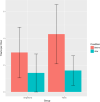Factors affecting yawning frequencies in preterm neonates
- PMID: 35522682
- PMCID: PMC9075618
- DOI: 10.1371/journal.pone.0268083
Factors affecting yawning frequencies in preterm neonates
Abstract
Yawning is a long neglected behavioral pattern, but it has recently gained an increasing interdisciplinary attention for its theoretical implications as well as for its potential use as a clinical marker, with particular regard to perinatal neurobehavioral assessment. The present study investigated the factors affecting yawning frequencies in hospitalized preterm neonates (N = 58), in order to distinguish the effects of hunger and sleep-related modulations and to examine the possible impact of demographic and clinical variables on yawning frequencies. Results showed that preterm neonates yawned more often before than after feeding, and this modulation was not explained by the amount of time spent in quiet sleep in the two conditions. Moreover, second born twins, known to be more prone to neonatal mortality and morbidity, showed increased yawning rates compared to first born twins. Overall, our results are consistent with the hypothesis that yawning frequencies in preterm neonates are modulated by separate mechanisms, related e.g. to hunger, vigilance and stress. These findings, although preliminary and based only on behavioral data, might indicate that several distinct neuropharmacological pathways that have been found to be involved in yawn modulation in adults are already observable in preterm neonates.
Conflict of interest statement
The authors have declared that no competing interests exist.
Figures
References
-
- Muchnik S, Finkielman S, Semeniuk G, de Aguirre MI. Yawning. Medicina (B Aires), 2003; 63(3): 229–232. - PubMed
MeSH terms
LinkOut - more resources
Full Text Sources


